Menu
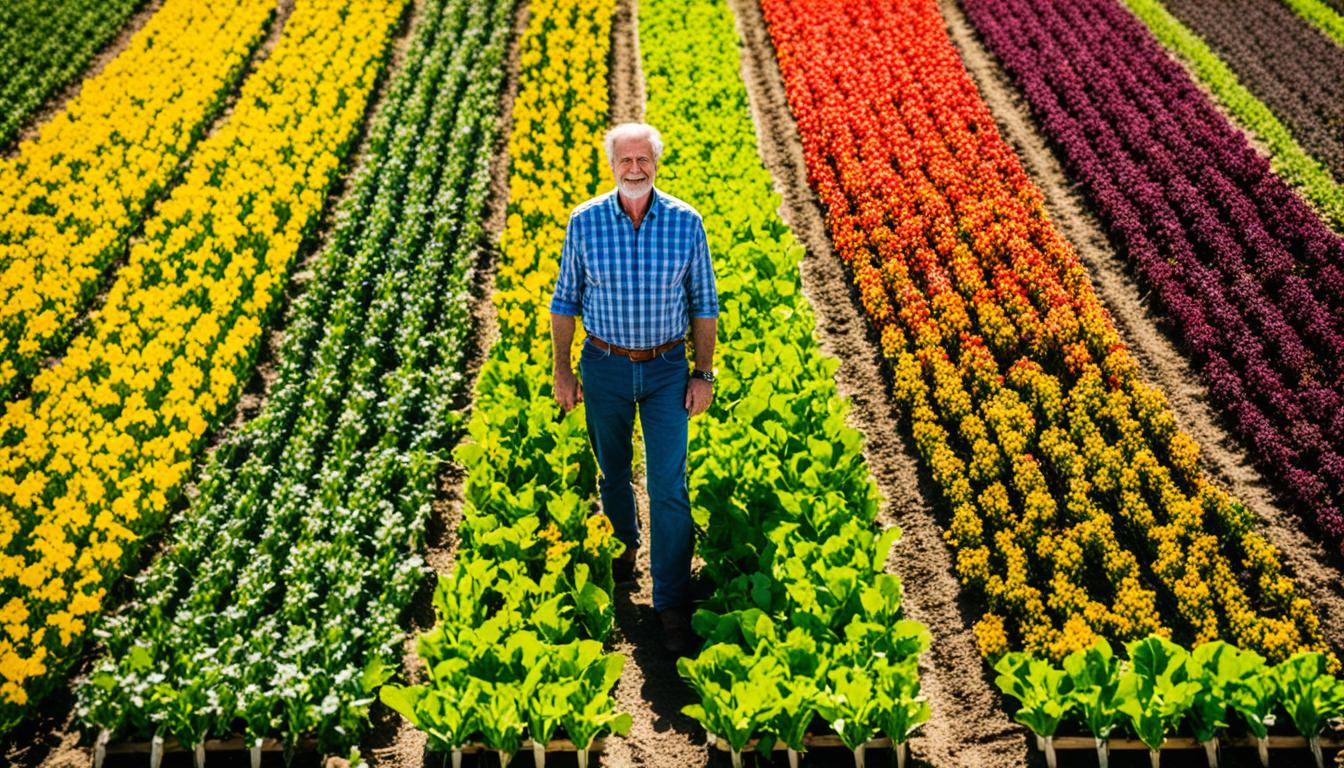
Winter in Minneapolis-Saint Paul, Minnesota, can go down to -25°F. Yet, expert Meg Cowden still does succession planting. This guide is all about making the most of each season to grow crops. It will teach you ways to plan your crops well, boosting your farm’s success.
This guide covers important things like managing crops, trying new farming methods, and using succession planting. It’s great for beginners and those already farming. You will learn to make your farm produce all year round.
Seasonal crop planning matches crop growth with the right season. It’s vital for using resources well and getting the most from your crops.
It’s all about picking the best times to plant and grow your crops. This method considers the weather and the soil, along with when crops grow fastest. Knowing this helps you manage your crops better.
It makes your growing season last longer by planting and harvesting at different times. This gives you food throughout the year and makes the most of your garden.
It also helps with pest control and keeps the soil healthy by harvesting at different times. Plus, keeping a diary helps you track your progress and change your plan if needed.
This method works well, especially in plant nurseries, where they carefully plan the best times to plant each species. Doing this makes sure they use their space perfectly and grow the best plants.
Meg Cowden, an esteemed author in the field, affirms the importance of these techniques, especially in regions with challenging climates.
| Component | Details |
|---|---|
| Propagation Protocols | Customised for each species and adjusted based on experience. |
| Crop Layout Planning | Based on the number of plants needed and available growing space. |
| Recordkeeping | Essential for tracking crop development and adjusting strategies. |
Understanding agricultural cycles is key in making farms work better and produce food sustainably. One key way is to match when you plant with the seasons. This makes crops grow better and improves their quality.
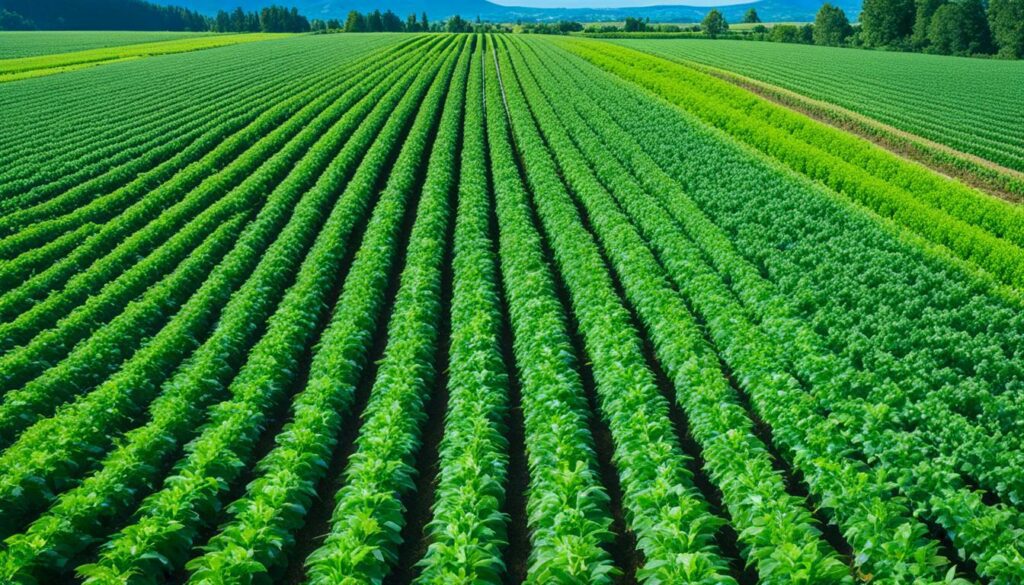
Knowing agricultural cycles well lets farmers use nature’s timing to grow more. For instance, planting certain crops at different times can extend the growing season. This uses resources wisely and boosts productivity.
Picking the right times to plant and harvest can greatly help the environment. It allows for better use of resources and less waste. Forecasting yields smartly makes sure crops grow well, like planting tomatoes in the best spots first.
It also helps keep the soil healthy for the future. Having backup plans for unpredictable events can make the farm more efficient and sustainable. These plans might deal with bad weather or not having enough workers. They help increase what the farm produces and how eco-friendly it is.
Seasonal farming means knowing how to grow crops during the right season. This method helps produce more crops that are healthy, and it’s good for the environment.
It’s important to know what each season needs for farming. Fall is when the harvest starts, from mid-September to early December. Then, farmers prepare the soil for next year’s crops. Winter, from early December to late February, is a time for farmers to rest and maybe go on holiday, like to Hawaii.
Spring comes after, from late March to late June, which is planting time. This is also when farming uses some weed and bug killers to keep the crops safe. It’s a time for new life on the farm, like baby kittens. Summer, lasting from July to early September, is very important. A scout checks the crops and makes sure they get the right food and medicine needed. The weather in summer, like rain and heat, is crucial for how well the crops do.
Some crops do best at certain times of the year. Knowing this helps farmers grow more food. For example, tomatoes and broccoli are planted at different times. This keeps the supply of fresh food steady.
| Crop | Optimal Growing Season | Growth Characteristics |
|---|---|---|
| Tomatoes | Spring to Early Summer | Needs lots of sun and warmth; fits well with organic farming. |
| Broccoli | Early Spring and Fall | Likes cool weather and enough moisture; good for growing different crops. |
Growing different crops that mature at various times is key. It helps extend the harvest season and keeps the land healthy. Farmers should always learn new ways to grow crops better, using help from groups like the USDA and universities.
Starting a great planting calendar starts with knowing your planting zones. These tell you the best times to plant and harvest. You get great results for your plants all year round. And, by planning right, you can grow just enough to avoid waste.
Good planning means better crops each year. Know the frost dates and what each plant needs. Then, plan when to sow to get the most out of your garden. You can use online tools to keep track of all your plantings and never forget a schedule.
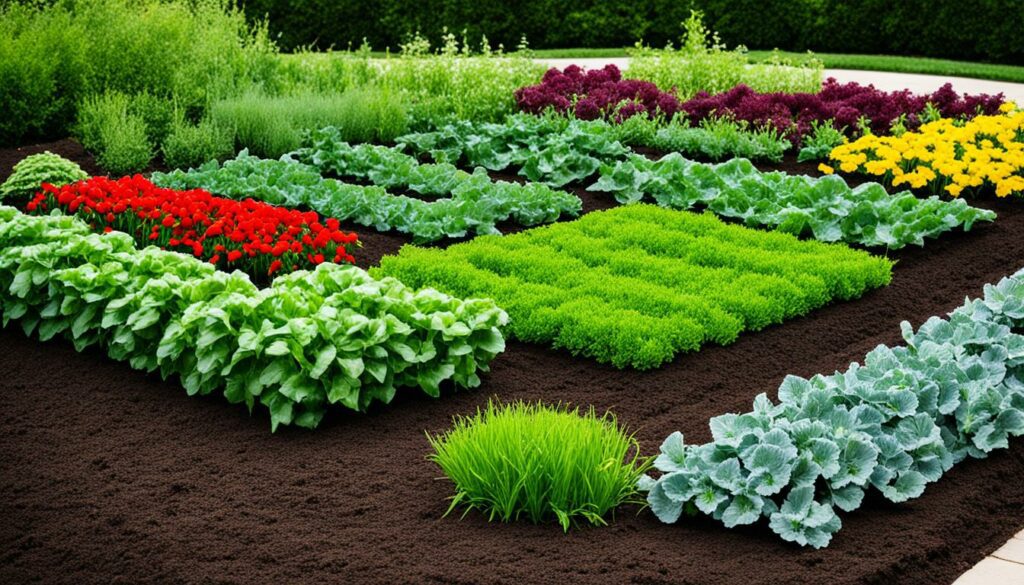
Your planting zones are crucial for a good planting calendar. You look at frost dates and what plants do well in your zone. Watching local weather helps plants grow better. Resources from the Seattle Urban Farm Co. stress the need to track what you plant and where, along with the weather. Keeping this info helps you make a solid calendar.
Getting the timing right is key for a strong planting plan. Crops should go in the ground at different times. Short season crops are planted a lot, while long season ones are planted less. Doing this means you always have fresh produce, and your garden works at its best.
It’s good to try different planting times. Start harvesting early, and keep going until late in the year. This way, you avoid common planting mistakes and always get good yields. Make a schedule just for your area. Think about how much food you need. This method gives you a great garden and lots of food. Check on your plants regularly. This lets you keep making your garden better and better.
Crop rotation helps keep the soil healthy and supports sustainable farming. It involves planting different crops in a planned order. This method helps control pests and keeps the soil rich in nutrients. Knowing the value of crop rotation is crucial for maintaining farming productivity and nature’s balance.
Crop rotation is key for good soil health and dealing with pests. Farmers plant different crops in a sequence to balance the soil’s nutrients. This keeps the soil fertile, meaning less need for harmful chemicals.
Crop rotation helps avoid soil compaction and supports plant growth. It also prevents soil erosion with crops that leave a lot of residue behind. Good soil structure leads to better crops and higher harvests.
To rotate crops, farmers must carefully choose which crops to grow. Plants like soybeans and peas are good because they improve the soil quality without the need for lots of fertilisers. Knowing the effects of different crops on the soil helps in planning rotations that keep the land productive and resilient.
Rotating crops can last several years and disrupt pest cycles. It makes plants healthier and better at using water. Soil also gets better at holding water, so crops can thrive even with less rainfall.
Crop rotation might sound simple, but it needs expertise and the right equipment. Most farmland grows crops in rows, like corn or wheat. Skilful crop rotation boosts pest control, saves resources, and is essential for lasting farming success.
| Benefit | Description |
|---|---|
| Soil Fertility | Restores depleted nutrients, balancing the soil nutrient levels. |
| Reduced Soil Compaction | Facilitates better seed germination and root growth. |
| Pest Management | Disrupts pest and disease lifecycles, reducing infestations. |
| Water Efficiency | Increases soil organic matter, enhancing moisture retention. |
| Soil Erosion | Utilises high-residue crops to prevent topsoil erosion. |
Achieving the best farm maximum yield strategies needs a smart harvest plan. I make a detailed calendar for each crop’s perfect picking time. This ensures they taste great and are full of nutrition.
Greenhouse growers have to set the right harvest times. If not, their plants might not be sellable yet or could be too big. A good plan stops these issues and boosts seasonal farming profit.
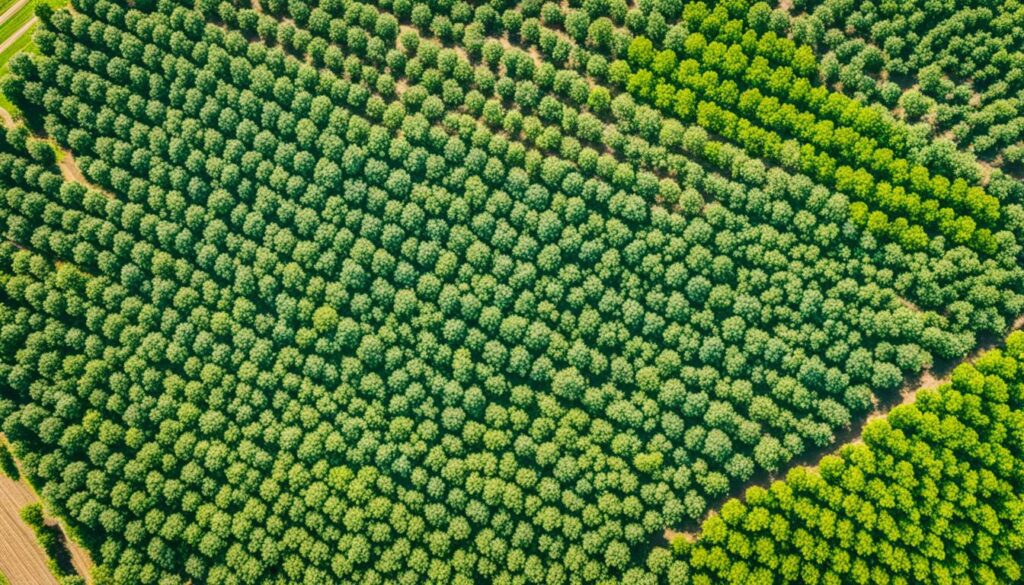
To make a solid harvest calendar, I look at when crops typically mature. Then, I pick the best time to start growing them based on when they should be ready to sell. This involves planning out how much seed or plugs to use. For spring crops, this means arranging your shipments early to avoid running out of supplies.
Virtual tools and advice from seed companies help a lot. They show how temperature impacts growth and help plan when to harvest things. This info is key for planning out the year’s planting.
Getting the harvest times right is key for a big crop and harvest optimisation. Tools like FlowersOnTime and advice from seed companies help a lot. They show how to manage planting for best results, like for tomatoes and flowers.
Succession planting can lead to multiple harvests. For instance, a friend in Virginia got three harvests from her raised beds in one season. This strategy makes a small plot wildly productive.
Using a seed starter tool and planting by the right moon phases can also help. This fine-tune the planting timing for maximum growth. Such careful planning is the secret to getting the most out of your farm.
Succession planting is a smart *gardening technique*. It creates an *extended harvest* by planting crops at different times. This method keeps the produce supply going and uses garden space well.
With succession planting, you plant seeds at different times. This helps you harvest multiple times in one season. It’s great for those who want to keep the garden productive all season long. Knowing when each crop will be ready and the climate helps make the most of your harvests.
If you love gardening, try planting different crops at different times. For example:
| Crop | Time to Maturity | Recommended Time Between Sowings | Last Recommended Sow Date | t
|---|---|---|---|
| Head Lettuce | 4-8 weeks | About 3 weeks | 4 weeks before the first frost | t
| Cucumbers | 50-70 days | 3-4 weeks | 4-6 weeks before the first frost | t
| Carrots | 55-80 days | 21-30 days | 3 months before the last frost | t
| Tomatoes | 50-85 days | 4 weeks | 60-80 days before the first frost | t
| Radishes | 3-5 weeks | 2-3 weeks | 4-6 weeks before the first frost | t
Using succession planting well can make your garden really productive. You get a variety of crops all season long. This *gardening technique* ensures an *extended harvest* and makes the best use of garden space.
Season extension methods are key to making gardens more productive and keeping crops safe from bad weather. I’ve found new ways to extend the growing season. This helps protect crops from harm.
High tunnels and hoop houses are affordable and great at extending the season. They use the sun’s heat and air flow to create a good climate for plants. Hoop houses are quick to set up and have a big impact on how well your crops grow. They have even helped businesses succeed more.
Greenhouses are a bit more expensive than hoop houses but offer better control. They have systems that automatically manage the temperature, cool the air, and water the plants. Their cost is worth it because they can bring in more money and better prices for your crops.
Low tunnels and caterpillar tunnels are good for keeping pests away and protecting plants during colder times. Cold frames help stop frost from hurting your plants. They can also make small, warmer areas where you can grow plants that usually need warmer weather.
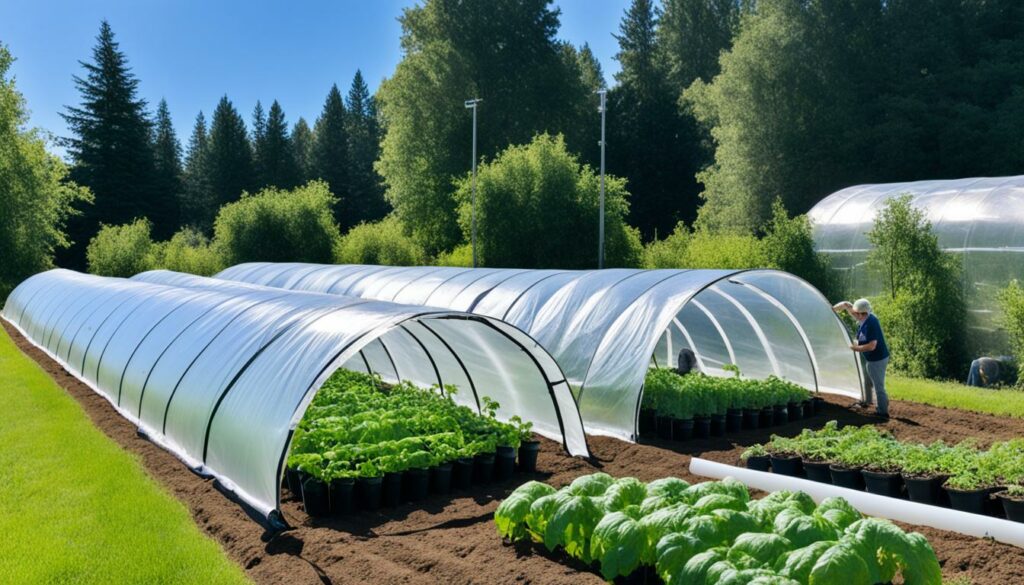
Picking the right plants for high tunnels is crucial. These plants must do well in warm, wet conditions. This is easy to manage because of the way high tunnels work. They also help control pests without using harmful chemicals.
| Tool/Technique | Primary Use | Benefit |
|---|---|---|
| Hoop Houses | Season Extension | Cost-effective, increases productivity |
| Greenhouses | Controlled Environment | Automated systems, premium crop prices |
| Low Tunnels | Pest Management | Protects cold-hardy crops |
| Cold Frames | Frost Protection | Creates microclimates |
Using drip irrigation in these structures is a smart idea. It keeps water away from the leaves of the plants, preventing disease. Using green energy sources for heat and power, like solar and biodiesel, is good for the planet and saves you money.
Methods like high tunnels and cold frames help us get more and better crops. They provide the right temperatures, moisture, and keep pests away. This is vital for producing food locally and not having to rely on food from far away.
Interplanting is key for using space wisely in a garden. It means planting different crops so they grow well together. This helps to use the space more efficiently.
This method relies on choosing the right mix of plants. They work together, not against each other. This way, they all get what they need without a fight.
Also called intercropping, it’s about growing different crops in the same place. It makes space work harder for you. By planting the right things together, you get extra benefits.
Interplanting can help with pest control and improve the soil. It also leads to bigger harvests. It’s about using plants’ natural abilities to help each other out.
To interplant well, you need to know which plants get along and how they grow. Here are some tips to get you started:
Adding cover crops and organic matter, like compost and manure, is also great for the soil. Putting compost on top in the spring helps a lot. Manure gives the soil important nutrients, like nitrogen.
Try not to plant the same types of plants in the same spot for 2-3 seasons. This keeps the soil healthy. It also boosts the crops you grow.
In a nutshell, interplanting is an effective way to make the most of your garden’s space. By choosing your crops carefully, you can increase your harvest, keep pests under control, and create a healthier garden. Following these steps leads to gardening that’s more productive and sustainable.
Good crop management is key to keeping plants healthy and getting high yields. It’s vital to watch out for plant health and use strong methods to control pests and diseases.
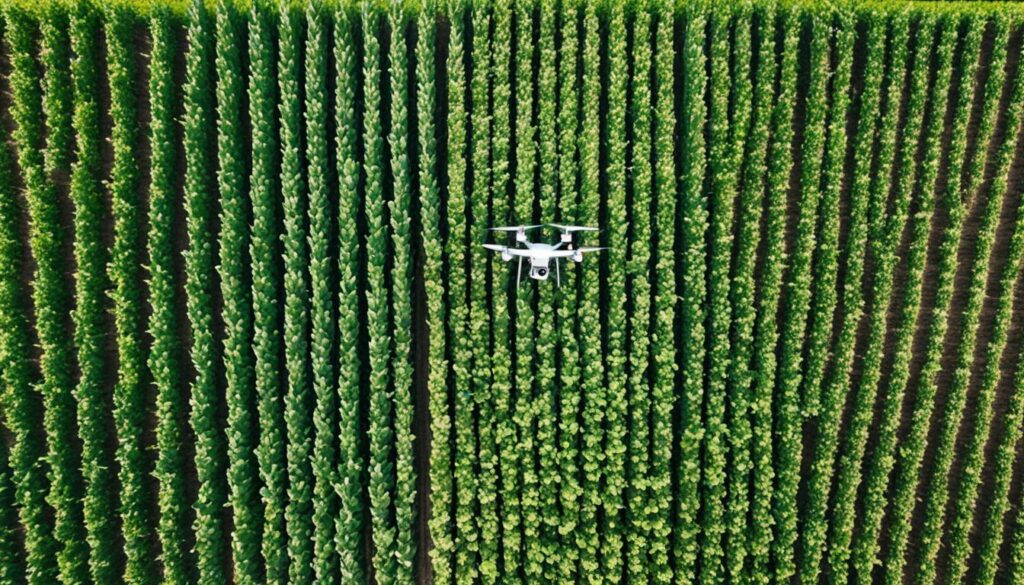
It’s crucial to regularly check crops for any early signs of trouble. Regular checks let you catch problems early. This stops diseases from spreading or pests from becoming a big issue.
When looking at your plants, observe any differences. Are the leaves a strange colour or shape? Are there bugs around? Catching these signs early prevents bigger issues later on.
Keeping pests and diseases in check without using harsh chemicals is very important. Organic ways, like letting helpful bugs loose or using natural deterrents, are good. Crop rotation and planting resistant varieties can also help a lot.
Crop rotation throws off pests and diseases by changing their environment. Mixing up what you plant and using plants that fight off pests can make your fields healthier. This leads to stronger plants that stand up better to harm.
Traditionally, tilling the soil would wear it down, making plants weaker to sickness and bugs. But, not tilling can help the soil get better and grow healthier plants. This way, plants become naturally tougher against diseases.
Trying new crop diversification methods in farming can make our farms stronger and more varied. Farmers are now planting different crops to face the issues of expensive land, higher costs, and unpredictable weather. This has become a popular and important way in farming today. It shows how essential these methods are for the future of agriculture across the world.
Having a variety of crops can hugely benefit farms. It helps in keeping the land rich and diverse. By growing more than one type of crop, it’s easier to deal with bad weather or price changes. This makes farms more financially secure and the land healthier.
To get the benefits of varied farming, start with your garden. Try planting different types of crops and mix up the planting. This not only makes the land healthier but also helps the environment. Diversification can prevent large losses, make the soil better, and increase what you can grow. It all leads to bigger and better crops.
While crop diversification has many good points, there are some challenges. These include finding people to buy what you grow, not enough equipment, and rules about farming. But with the right help and strategies, these problems can be overcome. This leads to a farming future that’s both strong and puts the environment first.
Starting with seasonal crop planning can be rewarding, especially for new gardeners. Start with a small area. This lets you learn without feeling overwhelmed. Later, you can grow your garden skills and space.
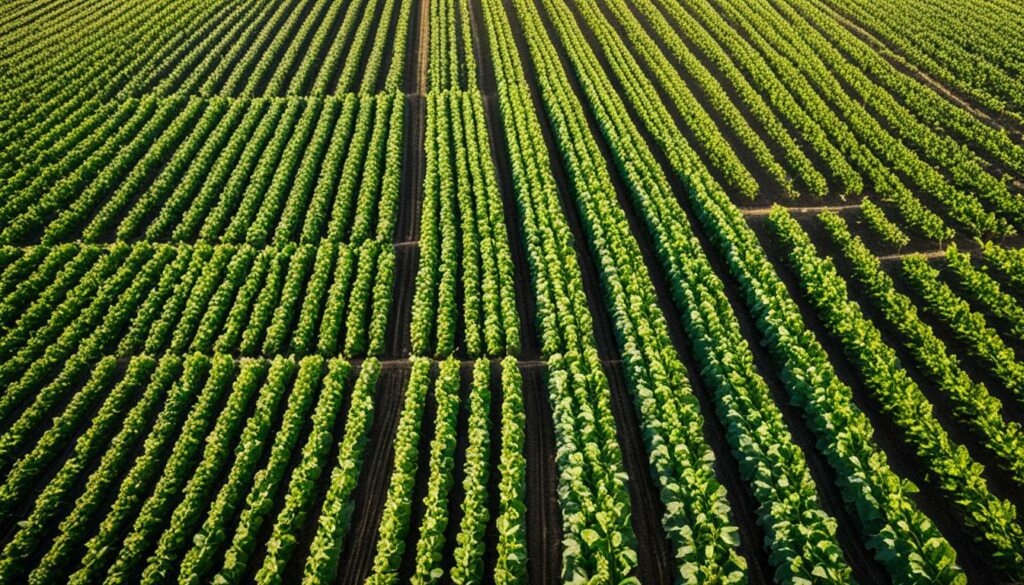
Begin with a small plot. This makes it easier to understand important steps, like preparing the soil and picking the right seeds. A 4-foot by 8-foot bed is a great start. It can feed one or two people.
Kale, lettuce, and tomatoes are perfect for beginners. They grow well in small spaces. This makes gardening fun and rewarding.
Use the right tools and resources for successful crop planning. Books, seed catalogues, and online forums are great for learning. They offer advice and tips from experienced gardeners.
Garden planners and apps are useful. They help you plan when to plant and harvest. This ensures your plants have the best conditions to grow.
Don’t forget about crop rotation. It keeps your soil healthy. Be aware of how long it takes for each crop family to return to the same spot. If it’s less than four years, you might need to change your mix of crops.
Plants have different needs. Leafy greens like lettuce and kale need at least six hours of sun. But, they’re happier with more. Root veggies and fruits need eight to ten hours of sun. Remember, all plants need enough water, about an inch a week, to stay healthy.
Following these steps and using helpful tools can lead to a great garden. With effort and knowledge, you can become a skilled seasonal crop planner.
In the world of agriculture, solving common problems in crop planning is key to good productivity and being kind to our planet. Farmers face issues like changing weather and keeping the soil healthy. They find new ways and stay ahead to tackle these challenges well.
Weather keeps changing, so building climate resilience in farming is now more important than before. Farmers use high-tech tools to predict the weather and make smart plans. Nevada, for example, heavily relies on alfalfa and grass hay farming. It’s vital there to use climate-resilient methods.
In Humboldt County, the variety of crop species dropped from five to six to three to four from 1978 to 1997. This shows why having a range of crops is crucial. More crop types help fight off weather risks, lower pest problems, and increase good bugs like pollinators.
Looking after soil well is also key for good crop planning. Using special soil care and fertilising methods can make the soil better. In Lincoln County, farmers increased the crops they planted from one or two to three or four between 1997 and 2012. This shows how important good soil is.
But, farmers often face problems like not enough people wanting their crops, troubles with getting their goods to the market, and lacking the right tools. In Nye County, the number of crops they grew fell from three to four to one to two from 1987 to 1997. Still, focusing on caring for the soil well can help overcome these issues and make crop production stronger.
Looking after the soil and being ready for the weather boosts crop production. Diverse crops not only keep the earth healthy but also bring more money. These steps protect farming for the future.
In my first year planting on a ¼ acre, I ran into some challenges. A lot of plants at once meant a huge harvest in late June. There was more than I could sell or use. This situation showed me the importance of planning well to avoid too much all at once.
Succession planting is a smart way to keep your garden producing more and spreading out the rewards. By not planting everything at the same time, flowers bloom throughout the season. Different plants need specific starting times, even with the same last frost date. For example, Calendula comes in 55-60 days, while Black Eyed Susans need about 120 days.
Splitting the field into segments makes it easier to plant a bit every week. This doesn’t mean more work, thanks to dealing with small areas at once. I plant in a way that allows two harvests from each spot. Classifying flowers helps me choose what to plant when. It’s all about fitting the crops to Washington’s weather, changing for heat or cold as needed.
For good succession planting, I space out plantings by a few weeks. This keeps the harvests steady. Watching how the garden and weather act helps. Lettuce may grow in 40 days, but other factors are at play. Planning where I save seeds for the next year’s crops helps keep everything going smoothly.
Seasonal crop planning means planting crops at the best time of year. This is to make sure they grow well. It also helps crops get the right weather they need.
Seasonal planning makes the growing time longer. This gives you food throughout the year. It also helps deal with pests better and makes the soil healthier.
Agricultural cycles are key for more crops and a greener planet. Planting the right thing at the right time and in the right way makes farms better. It also means we don’t waste resources.
Tomatoes and broccoli are some. Using seeds that grow at different times means you can have fresh food all year. From early spring to late winter.
Start by finding out about the area you’ll plant in. Keep a record of when plants grow and are ready to eat. This way, you’ll always have something growing.
Rotating crops keeps the soil healthy and bugs under control. Changing what crops grow in an area helps the soil stay full of good stuff. It also makes it hard for pests to survive.
Planning when to pick crops is important. Make sure to harvest them when they taste best and are full of goodness. This makes more money and food for people.
Succession planting means planting different crops one after the other. This way, you can have food for a longer time. It’s a smart way to keep your garden producing.
Use things like cold frames to protect your plants. This can make your garden feel like it’s in a warmer place. It lets you start planting sooner and keeps the harvest going longer.
Interplanting is growing different things close together. It uses the space you have well. It also means each plant can help the others grow better.
To keep plants healthy, watch them closely. Handle bugs and diseases early with safe methods. Using natural ways to fight these problems is good for plants and the environment.
Planting different crops makes farms safer and more fruitful. It reduces risks and helps the environment. It makes sure there is always something to eat.
Newcomers should begin with small projects to learn. Use guides and talk to other gardeners. This will build your knowledge and make you more confident.
Use weather tools and take care of the soil. These will help with the weather and keep the land healthy. It makes crop-growing more stable.
By planting things in a smart order, your garden keeps giving food. Doing this right means you can pick fresh produce for a long time.